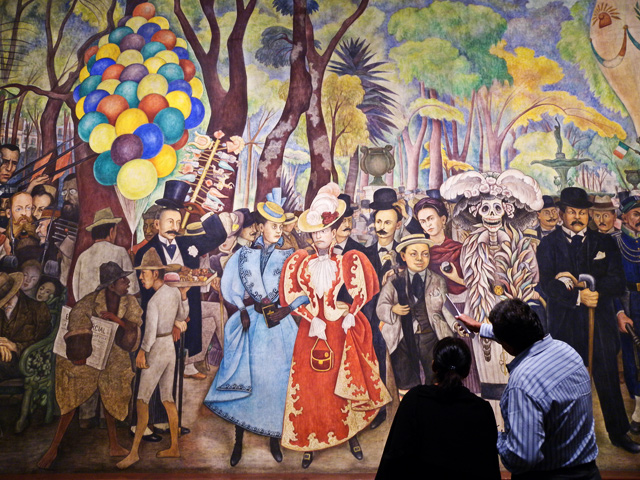
One of Diego Rivera’s most entertaining works is housed in the Museo Mural Diego Rivera, a small museum dedicated entirely to that piece. Photo © Ismael Villafranco, licensed Creative Commons & ShareAlike.
Murals abound in Mexio City, many of them painted by masters of the medium such as Diego Rivera. If you’d like to see the best of the best, make sure you visit these marvels on your next visit to Mexico City.
Many of the most well-known early-20th-century murals in Mexico City are located in old buildings in the Centro Histórico. Perhaps the most famous of these is the spectacular series entitled Epic of the Mexican People in Their Struggle for Freedom and Independence, by Diego Rivera, painted on the staircase and breezeways of the north patio in the Palacio Nacional. In moving detail, these paintings chronicle life in the pre-Columbian city of Tenochtitlán, the Spanish conquest, and the ensuing centuries of industrialization and exploitation.
The Antiguo Colegio de San Ildefonso was once the Escuela Nacional Preparatoria, a prestigious college-prep high school associated with the national university. In fact, Diego Rivera painted his very first mural here, La Creación, in 1922. David Alfaro Siqueiros, Fermín Revueltas, Ramón Alva de la Canal, Fernando Leal, and Jean Charlot also painted different sections of the space, though José Clemente Orozco’s murals in the main patio are the most extensive.
The headquarters of the Secretaría de Educación Pública, is the site of one of Diego Rivera’s most extensive projects. Rivera painted a beautiful series of murals here between 1923 and 1928, covering three stories of two adjoining patios.
The Palacio de Bellas Artes is worth a visit for its architecture alone, but the top floors of the building are also filled with important murals, including David Alfaro Siqueiros’s Nueva Democracia (New Democracy), painted in commemoration of the Revolution of 1910. There are additional works by Diego Rivera, José Clemente Orozco, Rufino Tamayo, and Juan O’Gorman on the top floors, which are worth the modest admission fee to view.
One of Rivera’s most entertaining works is housed in the Museo Mural Diego Rivera, a small museum dedicated entirely to that piece. Rescued from its original location—a hotel that was destroyed in the 1985 earthquake—this mural is aptly placed here, illustrating many of Mexico’s most famous figures in history.
The Museo Sala de Arte Público David Alfaro Siqueiros is a nonprofit contemporary-art space that aims to promote public-art projects in the grand tradition of Siqueiros and his contemporaries. Inside there are several galleries for rotating exhibitions, as well as a number of impressive, permanent murals by Siqueiros. The space also runs the Proyecto Fachada, wherein the building’s facade is repeatedly repainted by different artists.
Located just below the World Trade Center on Insurgentes Sur, the three-dimensional mural covering the inside and outside of the multipurpose arts space Poliforum Siqueiros is astonishing in its proportions, colors, and ambition. Inside the building, Siqueiros’s wonderful La Marcha de la Humanidad covers the walls and ceiling of an entire room.
One of the most recognizable structures at the Ciudad Universitaria, is the huge mosaic facade of the Biblioteca Central, designed by artist Juan O’Gorman and made entirely of colored volcanic stone. Just next door, adorning the rectory building, there is a mural by Siqueiros, and across Insurgentes is a stone mosaic on the Olympic stadium by Diego Rivera.
Excerpted from the Fifth Edition of Moon Mexico City.